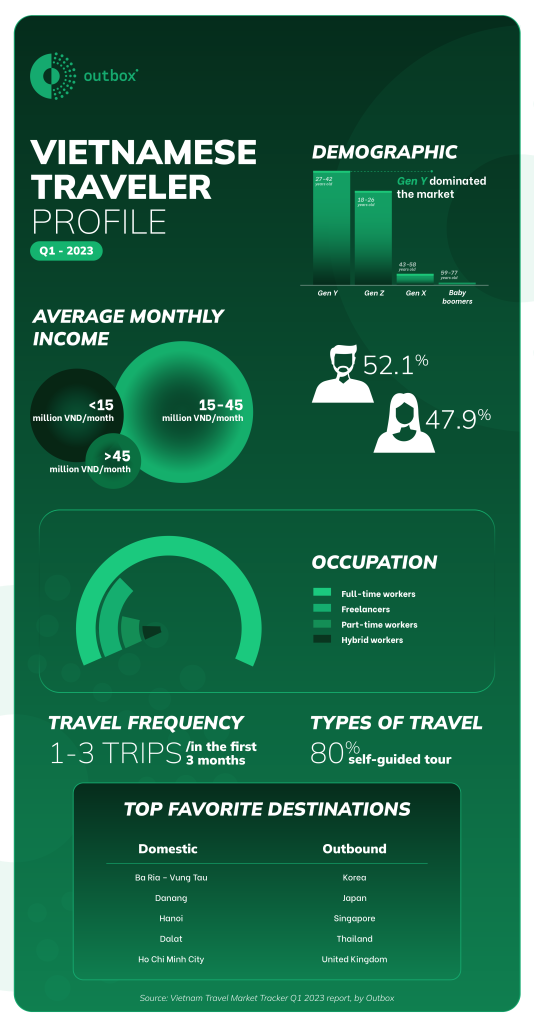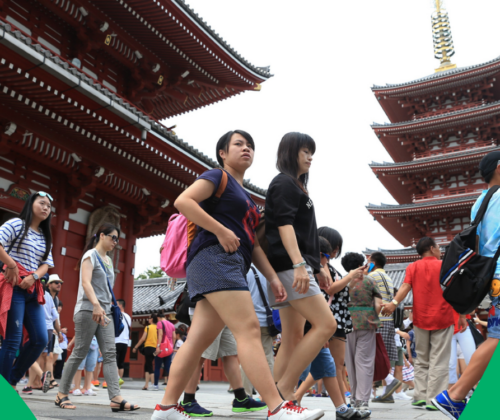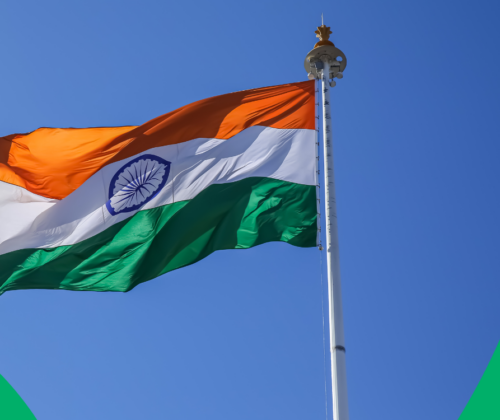What are the common characteristics of Vietnamese people traveling in the last quarter? In a report, Outbox’s survey of over 1,000 Vietnamese tourists in the first three months shows the following information.
Age: Gen Y decreased but still dominated the market
In Q1 2023, the majority of Vietnamese tourists were under 42 years old. Gen Y travelers (27-42 y.o.) accounted for the highest proportion, followed by Gen Z (18-26 y.o.). However, the gap between these two groups is not too much. There were not many Gen X and very few Baby boomers. Compared to 2022, the percentage of Gen Z and Gen X has increased. In particular, Gen Z saw a relatively high growth rate. It shows that this age group made more travel trips in Q1 after the pandemic was completely controlled. Meanwhile, there was a decrease in the number of Gen Y compared to last year.
Income: Increasing travel demand of travelers with good household incomes
Vietnamese tourists traveling in the first quarter with a good household income (15-45 million VND/month) accounted for more than half, followed by travelers with a household income of less than 15 million VND. Those with high household income (over 45 million/month) ranked last. Compared to last year, the proportion of tourists with a household income of less than 15 million/month decreased significantly, while those with a good household income increased. The proportion of visitors with a high household income did not change much.
It can be seen that economic difficulties and high inflation make households with incomes less than 15 million/month tighten their spending, leading to lower travel demand in order to pay for other essential needs.

Gender: The ratio of men and women quite balanced
The proportion of male and female visitors was quite similar in Q1 2023, with the number of male visitors slightly higher. Compared to last year, the proportion of male travelers saw a relative decrease, and the proportion of female visitors increased. It shows a balance in gender in Vietnam’s tourism market in the last quarter.
Occupation: Full-time workers predominated
The percentage of tourists working full-time accounted for more than half of Vietnamese tourists in the first quarter, followed by freelancers, part-time, and hybrid workers. In addition, the percentage of retirees traveling was very small. This partly reflects the similarity with the proportion of tourists by age as the proportion of retirees is almost equal to the proportion of Baby boomers.
Travel frequency: 1-3 trips in the quarter
Travel demand of Vietnamese tourists in the last quarter was still quite high (1-3 trips). The main reason is pent-up demand from 2022. Moreover, the long Tet holiday was also one of the factors pushing them to travel during this period.
Type of travel: Self-guided
Many Vietnamese travelers continued to choose self-guided tours. In Q1, up to 80% of tourists chose self-guided tours with their family and friends or alone.
Destinations: Domestic trips
Vietnamese travelers still prioritized domestic destinations in Q1 this year. The top 5 domestic destinations were Ba Ria – Vung Tau, Danang, Hanoi, Da Lat and Ho Chi Minh City, respectively. Among outbound destinations, Northeast Asia and Southeast Asia continued to be the most popular, namely South Korea, Japan, Singapore, and Thailand. The UK is the only non-Asian country in the top 5.
According to Outbox’s survey, there are some changes in Vietnamese travelers compared to the previous time. In Q1 2023, the biggest groups of tourists are those of Gen Y and Gen Z, people with a household income of 15-45 million VND/month, full-time workers, and there is no significant difference between men and women. They still had a high travel demand, preferring self-guided and domestic travel.
Outbox will continue to track whether and how they change in Q2 and further. This will help businesses and destinations firstly portray traveler profiles, then understand their behavior and psychology to plan and make decisions.



